Introduction
Red and confused flour beetles attack stored grain products such as flour, cereals, meal, crackers, beans, spices, pasta, cake mix, dried pet food, dried flowers, chocolate, nuts, seeds, and even dried museum specimens (Via 1999, Weston and Rattlingourd 2000). These beetles have chewing mouthparts, but do not bite or sting. The red flour beetle may elicit an allergic response (Alanko et al. 2000), but is not known to spread disease and does not feed on or damage the structure of a home or furniture. These beetles are two of the most important pests of stored products in the home and grocery stores. The confused flour beetle apparently received this name due to confusion over about its identity as it is so similar to the red flour beetle at first glance (Walter).
Distribution
The red flour beetle is of Indo-Australian origin (Smith and Whitman) and is found in temperate areas, but will survive the winter in protected places, especially where there is central heat (Tripathi et al. 2001). In the United States, it is found primarily in the southern states. The confused flour beetle, originally of African origin, has a different distribution in that it occurs worldwide in cooler climates. In the United States it is more abundant in the northern states (Smith and Whitman).
Description and Life Cycle
Although small beetles, about 1/8 of an inch long, the adults are long-lived and may live for more than three years (Walter).
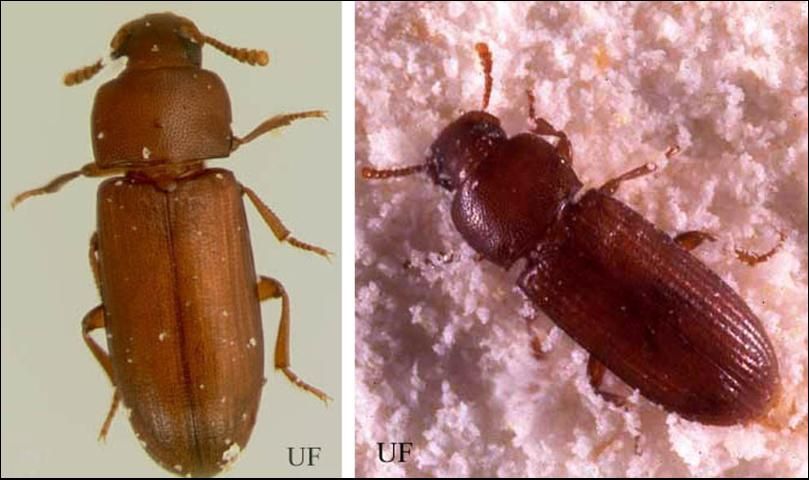
Credit: Rebecca Baldwin (red flour beetle) and James Castner (confused flour beetle), UF/IFAS
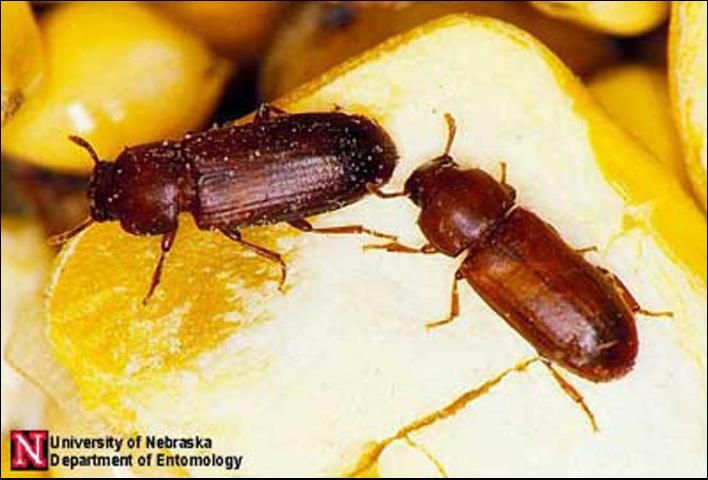
Credit: Jim Kalisch, University of Nebraska - Lincoln
The red flour beetle is reddish-brown in color and its antennae end in a three-segmented club (Bousquet 1990). Whereas the confused flour beetle is the same color but its antennae end is gradually club-like, the "club" consisting of four segments (Walter).
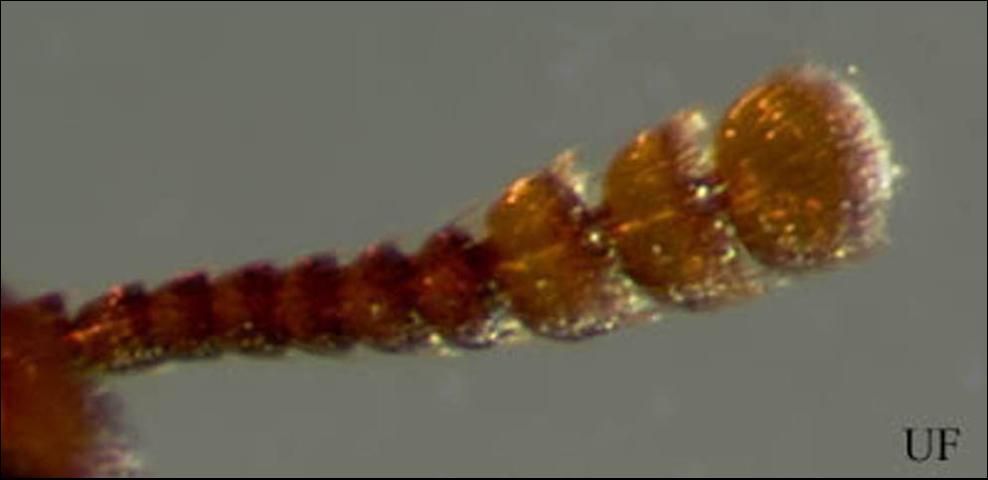
Credit: Rebecca Baldwin, UF/IFAS
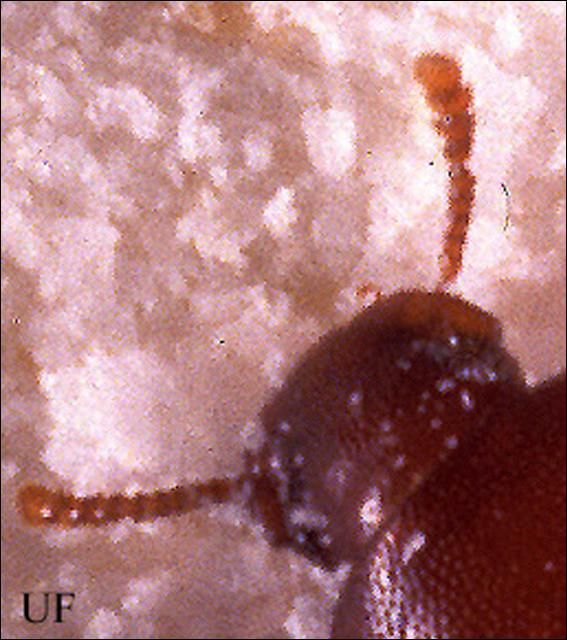
Credit: James Castner, UF/IFAS
The head of the red flour beetle is visible from above, does not have a beak and the thorax has slightly curved sides. The confused flour beetle is similar, but the sides of the thorax are more parallel (Anonymous 1986).
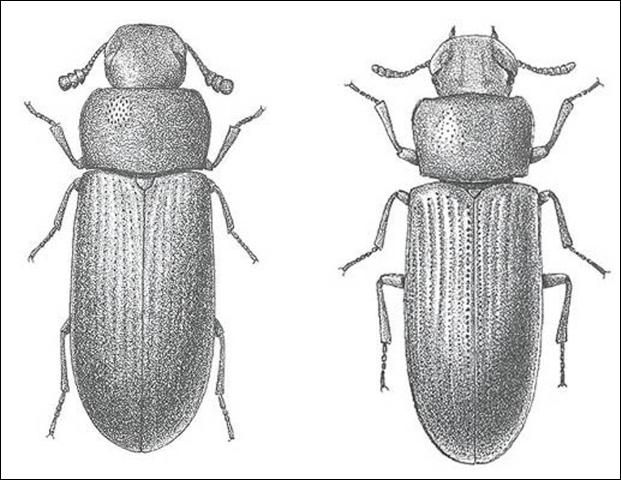
Credit: USDA
These two beetles are in the family Tenebrionidae and have a tarsal formula of 5-5-4 and notched eyes.
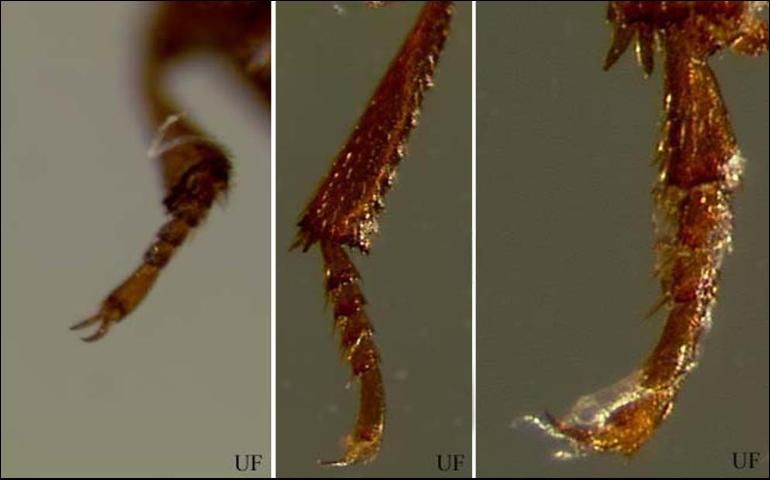
Credit: Rebecca Baldwin, UF/IFAS
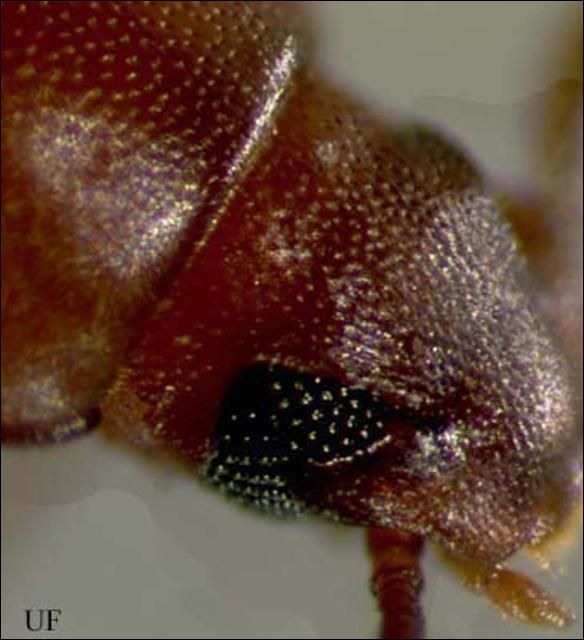
Credit: Rebecca Baldwin, UF/IFAS
The red and confused flour beetles live in the same environment and compete for resources (Ryan et al. 1970, Willis and Roth 1950). The red flour beetle may fly, especially before a storm, but the confused flour beetle does not fly. Eggs, larvae, and pupae from both species are very similar and are found in similar environments (Ryan et al. 1970). The eggs are white, microscopic and often have bits of flour stuck to their surface. The slender larvae are creamy yellow to light brown in color. They have two dark pointed projections on the last body segment.

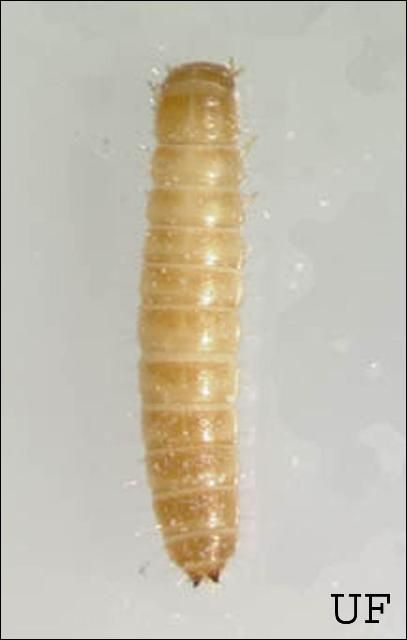
Credit: Rebecca Baldwin, UF/IFAS
The pupae are lighter in color, being white to yellowish.
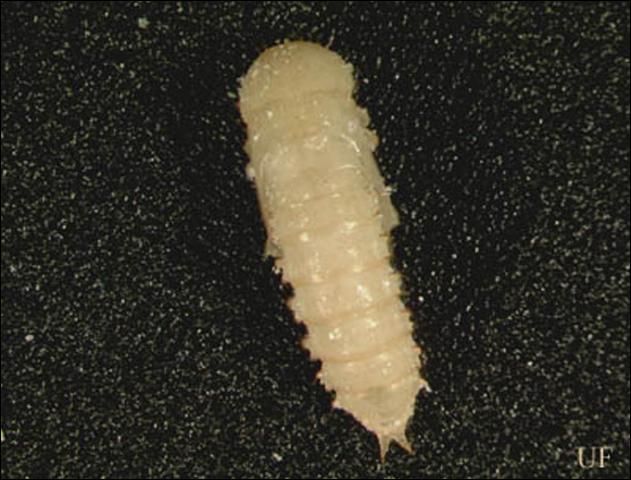
Credit: Rebecca Baldwin, UF/IFAS
These beetles can breed throughout the year in warm areas. The life cycle takes from 40 to 90 days, and the adult can live for three years. All forms of the life cycle may be found in infested grain products at the same time.
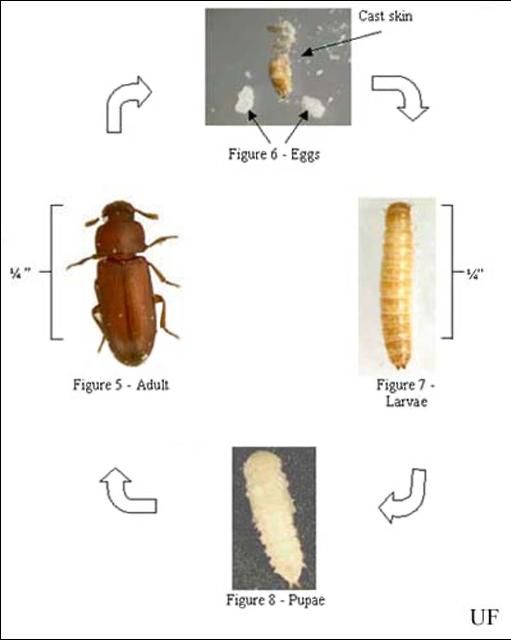
Credit: Rebecca Baldwin and Andrew Koehler, UF/IFAS
Habits
The red and confused flour beetles may be present in large numbers in infested grain, but are unable to attack sound or undamaged grain (Walter). The adults are attracted to light, but will go towards cover when disturbed. Typically, these beetles can be found not only inside infested grain products, but in cracks and crevices where grain may have spilled. They are attracted to grain with high moisture content and can cause a grey tint to the grain they are infesting. The beetles give off a displeasing odor, and their presence encourages mold growth in grain.
Management
The first step in managing an infestation is to find and remove the source of the infestation (Koehler 2003). Flour beetles can feed and survive on even the smallest bits of grain, so cleaning is a crucial part of controlling these pests. When attempting to locate the source, be sure to consider all likely food items including, dry pet food, dried flowers, nuts, birdseed, and all grain products. Be sure to look for "leaky packages." Small bits of meal or grain spilling from a package are often a signal that an infestation is present (Arbogast et al. 2000). Be sure to locate all infested material and discard it by placing the material into a sealed bag or container and throwing it into an outside garbage container. You may also place the infested material into a freezer for four to five days. These beetles may survive freezer times shorter than this.
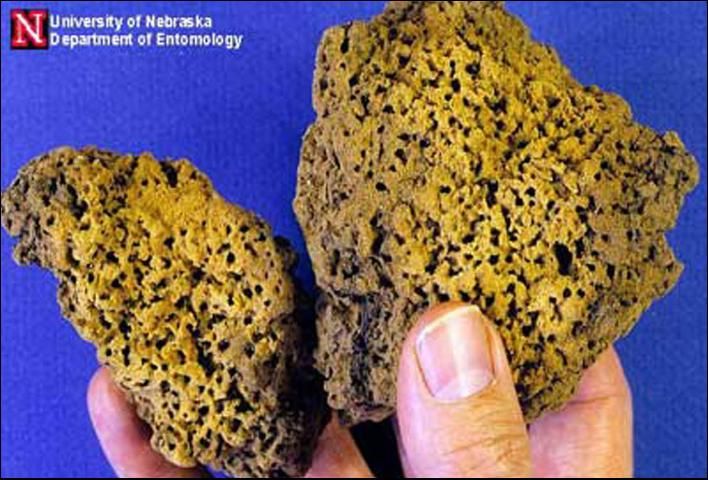
Credit: Jim Kalisch, University of Nebraska - Lincoln
Keep in mind that these beetles may infest areas other than the pantry. Be sure to inspect spices, pet food, and flower arrangements. Also keep in mind that some stuffing in furniture or stuffed animals may have natural products that these beetles could feed on. Also be aware of areas in which any of these products may have spilled, like under the refrigerator or stove. These beetles are able to locate very small bits of food. Once all of the infested material has been removed, be sure to vacuum and clean up the area around the infestation. If you have shelf paper, it would be wise to remove it, thoroughly clean under it with soap and hot water, and replace it with new paper. Be sure to pay close attention to the cracks and crevices of any cabinets. To prevent re-infestation, all grain products should be stored in containers with tight fitting lids, or stored in the freezer. Also consider where the infestation came from. It is likely that you could have a re-infestation by purchasing infested grain products from the same business. When shopping, look for those "leaky packages." If you suspect a beetle infestation, don't buy the product.
For more management information please see:
Florida Insect Management Guide for Stored Product Pests (https://edis.ifas.ufl.edu/IN027)
Florida Insect Management Guide for Stored Grain Pests (https://edis.ifas.ufl.edu/IG103)
Selected References
Alanko K, Tuomi T, Vanhanen M, Pajari-Backas M, Kanerva L, Havu K, Saarinen K, Bruynzeel DP. 2000. Occupational IgE-mediated allergy to Tribolium confusum (confused flour beetle) Allergy 55:879–882.
Anonymous. 1986. Stored-Grain Insects U.S.D.A. Agricultural Handbook 500.
Arbogast RT, Kendra PE, Mankin RW, McGovern JE. 2000. Monitoring insect pests in retail stores by trapping and spatial analysis. Journal of Economic Entomology 93:1531–1542.
Bousquet Y. 1990. Beetles associated with stored products in Canada. Canadian Government Publishing Centre, Ottawa 189–192.
Buss LJ, Fasulo TR. (2006). Stored Product Pests. UF/IFAS. SW 185. CD-ROM.
Cotton RT. 1950. Insect damage to stored grain and its prevention. Pest Control 18:8–10.
Fasulo TR. (2002). German Cockroach and Stored Product Pests. Bug tutorials. University of Florida/IFAS. CD-ROM. SW 165.
Granousky TA. 1997. Stored Product Pests. In Handbook of Pest Control, 8th Ed. Hedges SA, Moreland D (editors.). Mallis Handbook and Technical Training Company. pp. 635–728.
Hinton HE. 1948. A synopsis of the genus Tribolium Macleay, with some remarks on the evolution of its species-groups (Coleoptera: Tenebrionidae). Bulletin of Entomological Research 39:13–55.
Koehler PG. (April 2003). Pantry and Stored Food Pests. EDIS. https://edis.ifas.ufl.edu/IG095 (27 May 2003).
Ryan MF, Park T, Mertz DB. 1970. Flour beetles: responses to extracts of their own pupae. Science 170:178–180.
Smith EH, Whitman RC. 1992. Field Guide to Structural Pests. National Pest Management Association, Dunn Loring, VA.
Tripathi AK, Prajapati V, Aggarwal KK, Kumar S. 2001. Toxicity, feeding deterrence, and effect of activity of 1,8,-Cineole from Artemisia annua on progeny production of Tribolium castaneum (Coleoptera: Tenebrionidae). Journal of Economic Entomology 94:979–983.
Via S. 1999. Cannibalism facilitates the use of a novel environment in the flour beetle, Tribolium castaneum. Heredity 82:267–275.
Walter VE. 1990. Stored product pests. In Handbook of Pest Control (Story K, Moreland D. (editors.)). Franzak & Foster Co., Cleveland, OH. pp. 526–529
Weston PA, Rattlingourd PL. 2000. Progeny production by Tribolium castaneum (Coleoptera: Tenebrionidae) and Oryzaephilus surinamensis (Coleoptera: Silvanidae) on maize previously infested by Sitotroga cerealla (Lepidoptera: Gelechiidae) Journal of Economic Entomology 93:533–536.
Willis ER, Roth LM. 1950. The attraction of Tribolium castaneum to flour. Journal of Economic Entomology 43:927.